The Intel Core i9-9900KS Review: The 5 GHz Consumer Special
by Dr. Ian Cutress on October 31, 2019 10:45 AM ESTCPU Performance: System Tests
Our System Test section focuses significantly on real-world testing, user experience, with a slight nod to throughput. In this section we cover application loading time, image processing, simple scientific physics, emulation, neural simulation, optimized compute, and 3D model development, with a combination of readily available and custom software. For some of these tests, the bigger suites such as PCMark do cover them (we publish those values in our office section), although multiple perspectives is always beneficial. In all our tests we will explain in-depth what is being tested, and how we are testing.
All of our benchmark results can also be found in our benchmark engine, Bench.
Application Load: GIMP 2.10.4
One of the most important aspects about user experience and workflow is how fast does a system respond. A good test of this is to see how long it takes for an application to load. Most applications these days, when on an SSD, load fairly instantly, however some office tools require asset pre-loading before being available. Most operating systems employ caching as well, so when certain software is loaded repeatedly (web browser, office tools), then can be initialized much quicker.
In our last suite, we tested how long it took to load a large PDF in Adobe Acrobat. Unfortunately this test was a nightmare to program for, and didn’t transfer over to Win10 RS3 easily. In the meantime we discovered an application that can automate this test, and we put it up against GIMP, a popular free open-source online photo editing tool, and the major alternative to Adobe Photoshop. We set it to load a large 50MB design template, and perform the load 10 times with 10 seconds in-between each. Due to caching, the first 3-5 results are often slower than the rest, and time to cache can be inconsistent, we take the average of the last five results to show CPU processing on cached loading.
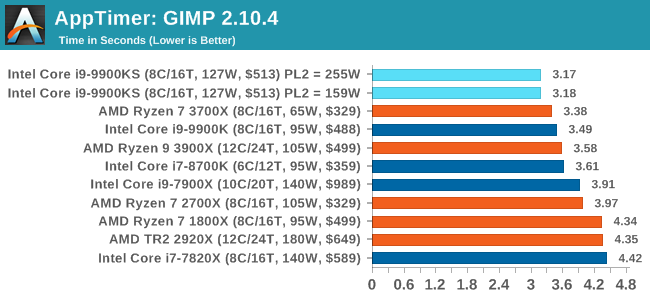
The 9900KS hits the top of all the consumer processors in our app loading test.
FCAT: Image Processing
The FCAT software was developed to help detect microstuttering, dropped frames, and run frames in graphics benchmarks when two accelerators were paired together to render a scene. Due to game engines and graphics drivers, not all GPU combinations performed ideally, which led to this software fixing colors to each rendered frame and dynamic raw recording of the data using a video capture device.
The FCAT software takes that recorded video, which in our case is 90 seconds of a 1440p run of Rise of the Tomb Raider, and processes that color data into frame time data so the system can plot an ‘observed’ frame rate, and correlate that to the power consumption of the accelerators. This test, by virtue of how quickly it was put together, is single threaded. We run the process and report the time to completion.
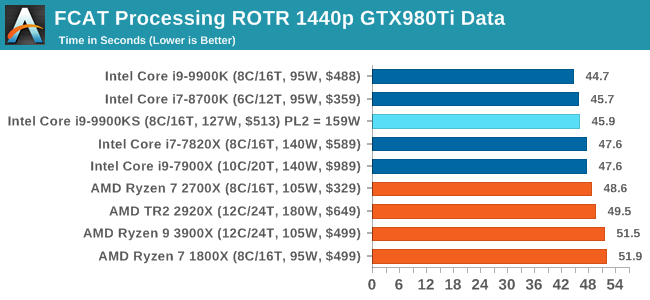
For some reason our default 9900KS run didn't seem to perform properly, but the 9900KS at Intel guidelines did, within the margin of error of the 9900K which also does turbo at 5.0 GHz.
3D Particle Movement v2.1: Brownian Motion
Our 3DPM test is a custom built benchmark designed to simulate six different particle movement algorithms of points in a 3D space. The algorithms were developed as part of my PhD., and while ultimately perform best on a GPU, provide a good idea on how instruction streams are interpreted by different microarchitectures.
A key part of the algorithms is the random number generation – we use relatively fast generation which ends up implementing dependency chains in the code. The upgrade over the naïve first version of this code solved for false sharing in the caches, a major bottleneck. We are also looking at AVX2 and AVX512 versions of this benchmark for future reviews.
For this test, we run a stock particle set over the six algorithms for 20 seconds apiece, with 10 second pauses, and report the total rate of particle movement, in millions of operations (movements) per second. We have a non-AVX version and an AVX version, with the latter implementing AVX512 and AVX2 where possible.
3DPM v2.1 can be downloaded from our server: 3DPMv2.1.rar (13.0 MB)
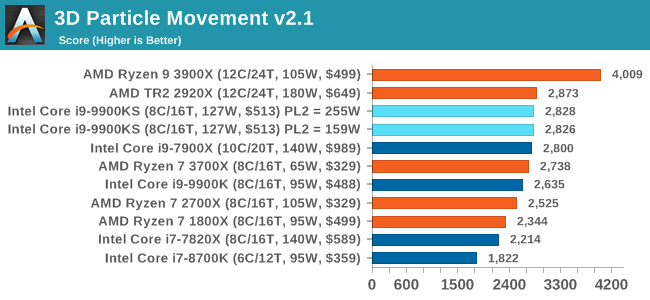
Without AVX acceleration, the Core i9-9900KS hardware manages to push ahead of the 9900K due to the extra frequency, and even above the 10-core 7900X. Because these are non-AVX instructions, they aren't pushing the CPU as hard as it can be, so we're not really draining the turbo bucket in our 159W PL2 test.
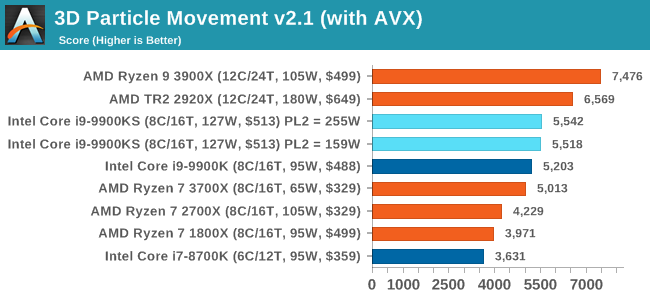
On the other hand, our AVX2 accelerated test is also showing both PL2 settings performing about equal. This test does involve a 10-second delay between each of its six subtests, which allows some turbo budget to be regained. Couple that with the 30 second delay between individual runs, it would appear that there's enough turbo budget for the whole run.
Dolphin 5.0: Console Emulation
One of the popular requested tests in our suite is to do with console emulation. Being able to pick up a game from an older system and run it as expected depends on the overhead of the emulator: it takes a significantly more powerful x86 system to be able to accurately emulate an older non-x86 console, especially if code for that console was made to abuse certain physical bugs in the hardware.
For our test, we use the popular Dolphin emulation software, and run a compute project through it to determine how close to a standard console system our processors can emulate. In this test, a Nintendo Wii would take around 1050 seconds.
The latest version of Dolphin can be downloaded from https://dolphin-emu.org/
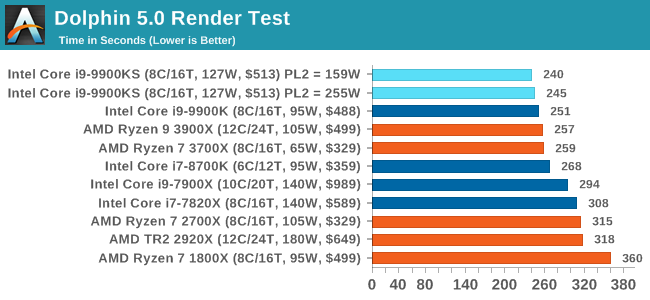
Dolphin loves single threaded performance, so we see the 9900 series at the top here.
DigiCortex 1.20: Sea Slug Brain Simulation
This benchmark was originally designed for simulation and visualization of neuron and synapse activity, as is commonly found in the brain. The software comes with a variety of benchmark modes, and we take the small benchmark which runs a 32k neuron / 1.8B synapse simulation, equivalent to a Sea Slug.
Example of a 2.1B neuron simulation
We report the results as the ability to simulate the data as a fraction of real-time, so anything above a ‘one’ is suitable for real-time work. Out of the two modes, a ‘non-firing’ mode which is DRAM heavy and a ‘firing’ mode which has CPU work, we choose the latter. Despite this, the benchmark is still affected by DRAM speed a fair amount.
DigiCortex can be downloaded from http://www.digicortex.net/
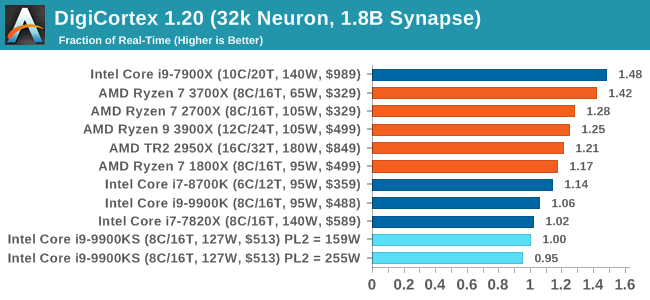
Interestingly enough the big splot in this benchmark series is here with DigiCortex. I'm not sure what's going on here; not only with the result being low (due to DDR4-2666 compared to AMD's higher support) but also lower than the 9900K.
y-Cruncher v0.7.6: Microarchitecture Optimized Compute
I’ve known about y-Cruncher for a while, as a tool to help compute various mathematical constants, but it wasn’t until I began talking with its developer, Alex Yee, a researcher from NWU and now software optimization developer, that I realized that he has optimized the software like crazy to get the best performance. Naturally, any simulation that can take 20+ days can benefit from a 1% performance increase! Alex started y-cruncher as a high-school project, but it is now at a state where Alex is keeping it up to date to take advantage of the latest instruction sets before they are even made available in hardware.
For our test we run y-cruncher v0.7.6 through all the different optimized variants of the binary, single threaded and multi-threaded, including the AVX-512 optimized binaries. The test is to calculate 250m digits of Pi, and we use the single threaded and multi-threaded versions of this test.
Users can download y-cruncher from Alex’s website: http://www.numberworld.org/y-cruncher/
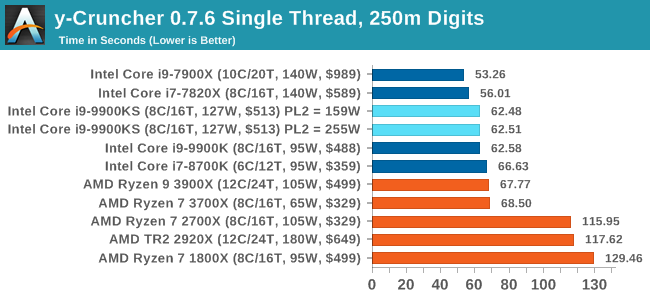
y-Cruncher can use AVX512 for the HEDT chips, as they are faster than the 9900KS, but all the 9900 series are performing similarly at 5.0 GHz single threaded here.
Agisoft Photoscan 1.3.3: 2D Image to 3D Model Conversion
One of the ISVs that we have worked with for a number of years is Agisoft, who develop software called PhotoScan that transforms a number of 2D images into a 3D model. This is an important tool in model development and archiving, and relies on a number of single threaded and multi-threaded algorithms to go from one side of the computation to the other.
In our test, we take v1.3.3 of the software with a good sized data set of 84 x 18 megapixel photos and push it through a reasonably fast variant of the algorithms, but is still more stringent than our 2017 test. We report the total time to complete the process.
Agisoft’s Photoscan website can be found here: http://www.agisoft.com/
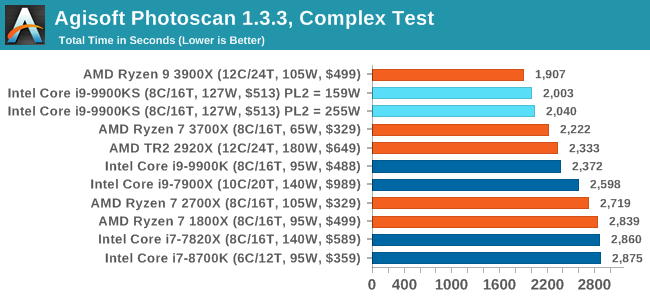
Agisoft is a more variable workload, so there will be bits here and there where both processors can fully go to 5.0 GHz turbo and recover budget. The 12-core AMD chip is ahead, and both 9900KS settings are almost equal. They are both ahead of the normal 9900K by just over 10%.













235 Comments
View All Comments
liquid_c - Sunday, November 3, 2019 - link
One of the few reasons i keep reading articles from sites / news outlets like Anandtech and ArsTechnica is the fact that besides good, well developed and portrayed journalism, i also expect knowledgeable people commenting on said articles. I always learn(ed) a little bit of extra info by doing so and it pains me to see this ongoing fan war between Intel / AMD fans, Apple / *Insert any other Android vendor name* fans, etc. So instead of finding out the “ifs” and “whens” of specific tech topics, i have to skip through countless hate posts.PeachNCream - Monday, November 4, 2019 - link
People in glass houses.... liquid_c - Sunday, November 03, 2019 - Stop being such a dummy and stop acting like a rabid dog over a product that not only you will never get but clearly, it's not geared towards you.Although I agree in principal that there are a fair number of toxic comments, yours are among them so I don't think you have much room to complain while at the same time contributing to the problem.
sorten - Sunday, November 3, 2019 - link
The 65W 3700X is the star of this show.shompa - Monday, November 4, 2019 - link
The main problem is: 16 PCI lanes. You can't really connect anything to the system without starving it for bandwidth. The 16 PCI lanes are used for graphics. DMI link to the motherboards PCI lanes has a bandwidth of 3.8GB/s. 4-year-old NVme SSDs are already at 3.5GB/s. Forget using 2 NVme. Usually, the graphics card is pushed to 8PCI lanes killing 10% performance. Forget connecting fun stuff with a thunderbolt, or use high-end capture cards and so on. There is no bandwidth. AMD Ryzen 3 with X570 is a bit better: 24 PCI lanes. 16 for PCI and 2x4 for dual NVme SSD with 8GB/s support.trojtalen - Wednesday, November 6, 2019 - link
Really? In FarCry i missing Ryzen 3000 generation, why?...Sorry but in Vulkan (Strange Brigade) its shame! 65W AMD beat 250W+ intel on 5GHz? :D:D:D LOLalufan - Thursday, November 7, 2019 - link
so this has been the main front page story on this site for the last 8 Days strikes me as a little biased other CPUs come and go yet intels last gasp attempt to make something matter is upfront and centre for over a week strikes me as a little unfairjonbar - Thursday, November 7, 2019 - link
So.... În other review, Ryzen slaughtered 9900ks in blender, even 3700x is faster :)Some say in gaming it's faster than 3900x, but so is 9700k with 2080 :) 9700k is on par with 9900ks.
Other than "having the best of the best", 9900ks requires a lot more spending to open it's full potential. From this review, 3700x is really, really good all-round with minimal spending a 100$ B450 and a good 550w psu
Maxiking - Thursday, November 7, 2019 - link
Any Ryzen CPU is getting slaughtered in gaming by piss poor 9700k without HT so your point? Don't hate things just because you are too poor to afford them. We rich bois don't care. Don't forget to attend Fridays for future today.jonbar - Friday, November 8, 2019 - link
:) how could you live a day without insults.People asked why no ryzen 3000 results for blender, and slaughters is when a 127W-rated, "special edition" "all cores 5GHz all times", 550$+ CPU doesn't even manage to beat the 3700X at 325$.
People also asked why 1080 and argued that 9900ks is still better for gaming, guess what - on a 2080, de difference is not so great, other than Hitman, 9700k (piss poor? I suppose rich boys don't know that it, at the moment, is 30$ more expensive than 3700x, with no cooler AND requires the Z mobo to overclock :)
Maxiking - Friday, November 8, 2019 - link
Yeah, I am asking too why that allegedly excellent 7nm cpu with HT is unable to beat a piss poor 14nm 9700k with HT disabled? See, there is a reason why it is so cheap.Yes, it is a piss poor version of 9900k with disabled HT, the silicone quality is subpar by Intel high standards and those pieces are unable to reach 5ghz boosts with HT being enabled , so Intel disabled the HT and sell them as 9700k. Of course, I should not forget to mention that 9700k is a piss poor quality cpu only by the high Intel standards and high Intel customers standards.. We do not bother with anything below 4.7 Ghz.
By AMD standards, anything reaching 4.0 is a godly cpu and is being binned and sold as 3900x for the premium and they are pumping up to 1.55v into it so it can reach that mighty 4.3ghz boost on a single core whilst they promised 4.6ghz.
Let's wait for 3950x and the promised 4.7ghz boost. You know, I smell a trap. Not that kind of one, you pervert. 3900x is able to reach 4.6ghz for microseconds so, that 4.7ghz boost won't be most likely even measurable because such tiny time unit the boost would be active for hasn't been discovered yet.